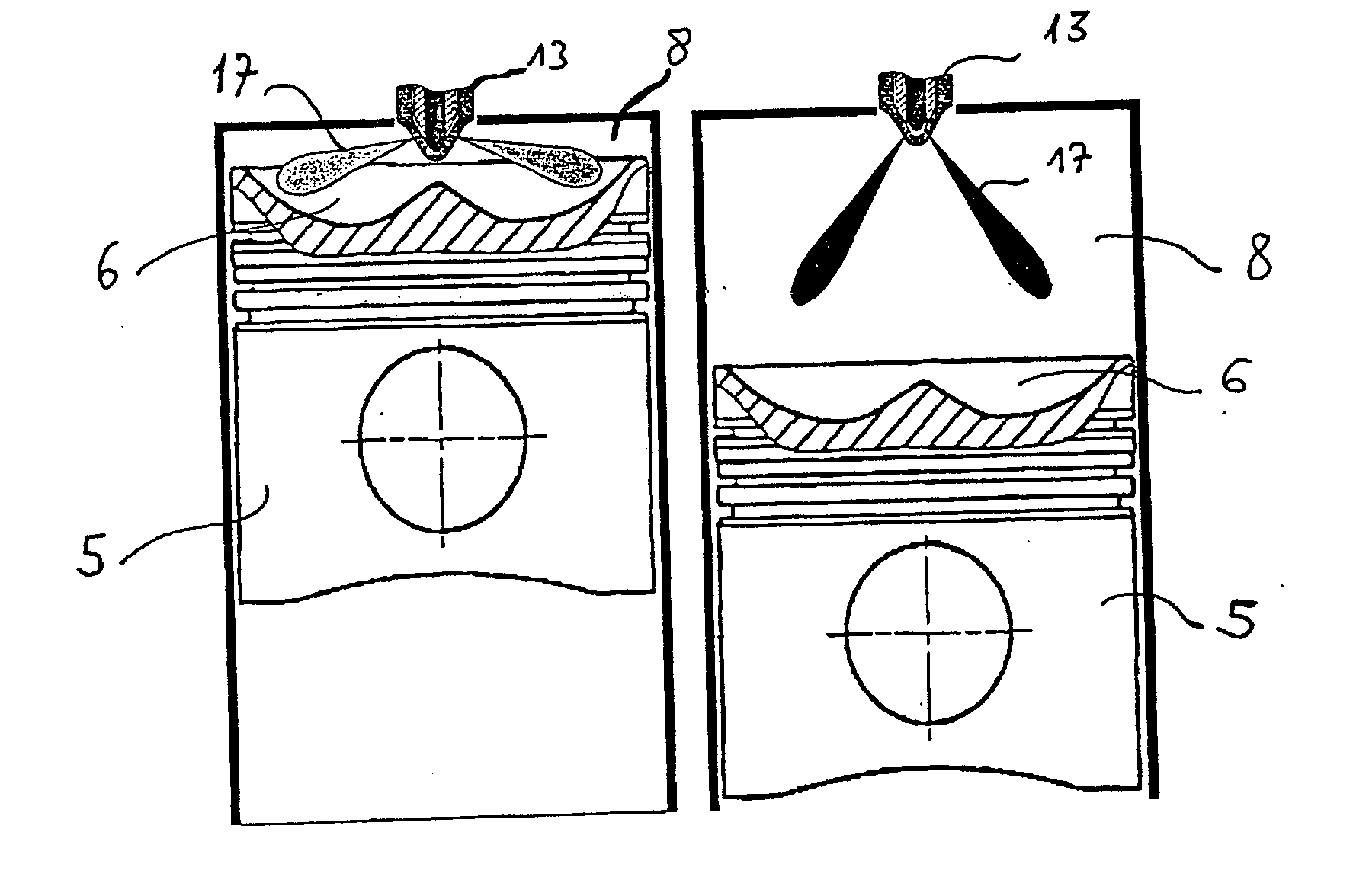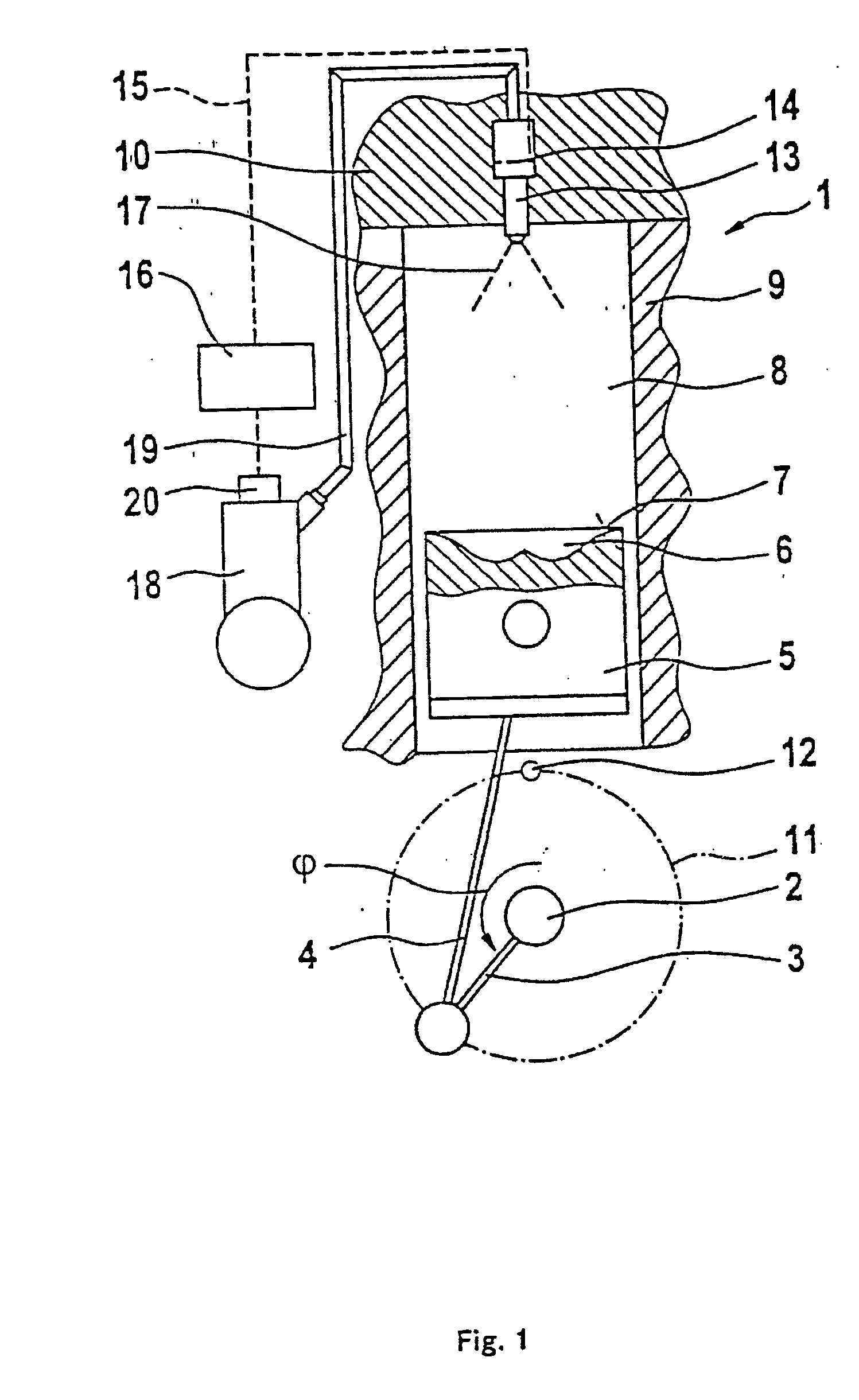[0007] Accordingly, a controlled injection of the fuel for varying the jet length in the combustion space can be carried out as a function of the
piston position in the cylinder, with the result that the intermixing of the injected fuel with the combustion space air, particularly during preinjection and postinjection, takes place before the cylinder wall is reached. A
wetting of the cylinder wall with fuel can thereby largely be avoided.
[0008] According to a refinement of the invention, the rows of holes of the injection nozzle have different injection-hole cone angles. The fuel can thereby, in particular, be introduced into the combustion space at a steeper injection angle during a preinjection or during a postinjection than during the main injection. The jet length in the combustion space can thus be adapted as a function of the distance between the injection nozzle and the
piston, so that a variation in the jet length in order to optimize the
mixture formation is thereby ensured or made possible.
[0009] In a further refinement of the invention, a first row of holes of the injection nozzle is activated during main injection and a second row of holes is activated during preinjection and / or postinjection, the injection-hole cone angle of the first row of holes being higher than the injection-hole cone angle of the second row of holes. In this case, during the main injection, the fuel is injected around a
top dead center through the first row of holes at a flat injection-hole cone angle, preferably of between 140° and 160°. By contrast, in the event of early and / or late
fuel injection, the fuel is injected into the combustion space at a steep injection cone angle, for example of between 60° and 160°, through the second row of holes arranged preferably below the first row of holes. This makes it possible to have an optimum jet length in the combustion space during an injection operation. According to the invention, depending on the
operating point, an injection operation comprises a main injection and, as required, a preinjection and / or postinjection.
[0011] In a further refinement of the invention, an operating
stroke of the nozzle needle of the injection nozzle can be set in such a way that an unstable cavitating flow is formed in the injection bores of the injection nozzle. Preferably, during the preinjection and / or postinjection, the fuel is injected intermittently in the form of small part quantities. Accordingly, owing to the variable setting of the operating
stroke of the nozzle needle of the injection nozzle, in the case of each preinjection or postinjection part quantity injected into the combustion space, the atomization of the respective fuel jet in the combustion space can be reinforced, so that a wall accretion of fuel in the cylinder, which, for example, rises continuously in the case of a lower
gas pressure and lower temperature in the cylinder, is minimized. Thus, according to the invention, the range of each part quantity up to a combustion space wall is limited and an intensified break-up and
evaporation of the injection jet or of the part quantity, particularly with an increasingly later start of injection, are achieved.
[0012] According to a further refinement of the invention, a swirl movement can be set in the combustion space of the
internal combustion engine. Preferably, a generated fuel cloud of a fuel jet (17) is offset or laterally displaced by the swirl movement set in the combustion space, in particular during a fuel injection carried out intermittently. As a result, for example, the formed fuel cloud of a part quantity, when it penetrates through the combustion space, can be laterally displaced, in particular in the direction of a cylinder wall. The fuel jets or the fuel droplets are thus moved away or moved further from the cylinder wall during their propagation, so that they are intermixed with the combustion space air or evaporate, in particular during preinjection and postinjection, before they reach the cylinder wall. A wall accretion of fuel in the cylinder is thus largely prevented. If there is no swirl movement in the combustion space, the fuel jet is propagated along an injection-hole center axis and impinges onto the cylinder wall on account of the short travel up to the cylinder wall. Furthermore, in this case, the preceding jet parcels or the jet parcels emerging first from the injection nozzle form a jet duct which results in an accelerated penetration of the following jet parcels or part quantities due to a lee effect, so that, in the absence of a swirl movement of the combustion space, an impingement of fuel onto the cylinder wall becomes more likely.
[0015] According to a further refinement of the invention, the piston recess has, starting from the piston head, first, a flat entry with a low curvature and, from the region of the maximum recess depth, a greater curvature extending into the piston recess projection. This prevents an accretion of fuel in the region of the piston head and thus achieves a minimization of
exhaust gas emissions. Preferably, the piston recess projection has a cone angle in a range of 90° to 160°.
 Login to View More
Login to View More  Login to View More
Login to View More 


